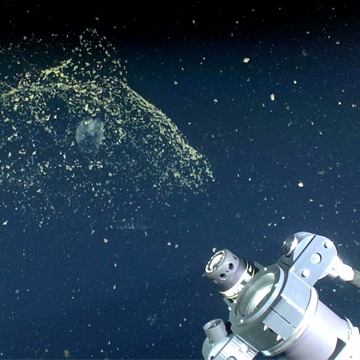
This frame grab from video taken by MBARI’s ROV shows the inner and outer houses of a giant larvacean (left) and the DeepPIV system (lower right). [Image: © 2015 MBARI]
Scientists from the Monterey Bay Aquarium Research Institute (MBARI), USA, have created a new particle image velocimetry (PIV) method—called DeepPIV—for measuring water filtration rates of giant larvaceans, tadpole-like sea creatures a few centimeters in size that reside in meter-size, self-made mucus “houses” that act as food-particle filters (Sci. Adv., doi: 10.1126/sciadv.1602374). Because giant larvaceans are so ubiquitous, their rate of organic-particle consumption can provide valuable information about oceanic carbon cycling. This could, the researchers say, improve computer models of climate change.
Unlike older versions of PIV that measured fluid rates in the lab, DeepPIV is deployed via a remotely operated vehicle (ROV) that can dive into the deep ocean where giant larvaceans live. The laser-and-camera setup records how fast the larvaceans can filter food particles through their mucus houses and into their mouths. Based on DeepPIV data collected from 13 dives, the MBARI team reports that the average filter rate of giant larvaceans in Monterey Bay is four times higher than previous estimates.
Measuring filtration rates in the deep
Principal engineer Kakani Katija and her colleagues created DeepPIV as a way to record filtration rates of giant larvaceans in situ because the animal’s mucus houses are too delicate to contain and study in the lab. The DeepPIV box is attached to the arm of an oceanic ROV that’s equipped with a camera. Inside the DeepPIV box is a continuous 1-W, 671-nm laser and line-generating optics that can project a 1-mm-thick 20×20-cm sheet of light 50 cm in front of the ROV camera. The ROV high-definition, 1920×1080-px camera records 60 frames per second with a field of view that ranges from 13×7 cm to 165×90 cm.
Once the ROV camera spots a giant larvacean, DeepPIV projects a sheet of laser light onto the creature. As the light sheet passes through the larvacean, the camera captures not only the shape of the diaphanous mucus houses, but also the movement of particulate matter toward the animal’s mouth. The researchers used the length of particle streaks to measure flow rate. Sizing lasers or reference objects measured larvaceans’ size.
From June 2015 to December 2015, the researchers collected flow rate and size data on 24 giant larvaceans, which they combined to calculate filtration rate. Katija and her colleagues report that a giant larvacean filters on average 42.9 liters per hour, with a maximum rate of 76.2 liters. (Based on these findings, the giant larvacean takes the title of world’s fastest zooplankton filterer away from its barrel-shaped cousin, the salp.)
Estimating large-scale impact
The researchers estimated giant larvaceans’ large-scale filtration impact on Monterey Bay by combining DeepPIV-acquired filtration rates with population estimates and how much time per day the creatures spend filtering water. Their results showed that it could take as little as 13 days for giant larvaceans to filter all the water in their deep-ocean home.
Based on their large-scale filtration impact estimates, the MBARI team says that giant larvaceans have a much greater contribution to oceanic carbon cycling than was previously predicted by indirect data measurements. They conclude that further in situ studies of other oceanic filter-feeders enabled by their DeepPiv technology “will lead to more accurate assessments of the role of deep-water biota in the long-term removal of carbon from the atmosphere.”
